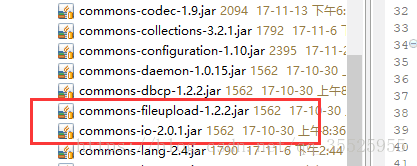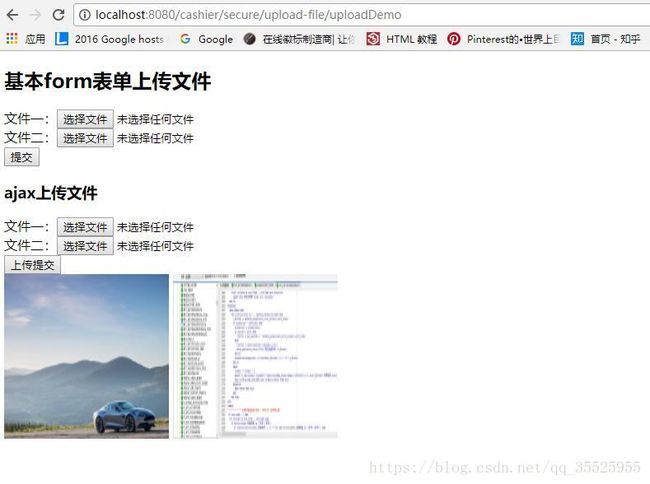springMVC上传文件,使用MultipartHttpServletRequest、MultipartFile进行文件上传
这里使用apache的开源jar包完成上传功能,使用jar包分别是:common-fileupload.jar和common-io.jar

先编写上传文件帮助类,如果需要区分文件类型,可以将文件后缀截取进行判断;
springmvc-mvc.xml配置,这里主要配置springmvc解析器CommonsMultipartResolver等等,这里主要是配置文件上传解析器,下面是配置文件代码:
text/html;charset=UTF-8
编写文件上传帮助类
注意:文件上传时,会有上传多个文件的功能,所以文件上传帮助类方法可以写成返回 List 集合,
这样就可以基本满足单个和多个文件上传使用,不多说了,上代码:
/**
* 上传文件帮助类
*
* @author ajie
*
*/
public class FileUploadUtil {
// 使用日志工厂获取日志对象
private static Log log = LogFactory.getLog(FileUploadUtil.class);
/**
* 批量上传文件
*
* @param request
* @param response
* @param username
* 用户名; 用于区分用户上传的图片
* @param moduleName
* 模块名称; 用于区分该图片是位于那个模块进行上传
* @return
* @throws FileNotFoundException
*/
public static List uploadFile(HttpServletRequest request, String username,
String moduleName) throws FileNotFoundException {
// 创建list集合,用于接收上传文件的路径
List filePathList = new ArrayList();
// 拼接文件上传位置,这里使用Tomcat服务器,将文件上传到webapps中,和项目同目录,files将用于保存上传的文件,将上传的文件于项目分开
String strPath = ",webapps,files," + moduleName + "," + username;
// 解析出文件存放路径位置
String filepath = System.getProperty("catalina.base") + strPath.replace(',', File.separatorChar);
log.debug("文件上传路劲位置-------->>>>>>>>>>>>" + filepath);
// 转换request,解析出request中的文件
MultipartHttpServletRequest multipartRequest = (MultipartHttpServletRequest) request;
// 获取文件map集合
Map fileMap = multipartRequest.getFileMap();
String fileName = null;
// 循环遍历,取出单个文件
for (Map.Entry entity : fileMap.entrySet()) {
// 获取单个文件
MultipartFile mf = entity.getValue();
// 获得原始文件名
fileName = mf.getOriginalFilename();
// 截取文件类型; 这里可以根据文件类型进行判断
String fileType = fileName.substring(fileName.lastIndexOf('.'));
try {
// 截取上传的文件名称
String newFileName = fileName.substring(0, fileName.lastIndexOf('.'));
log.debug("上传来的文件名称------->>>>>>>>>" + newFileName);
// 拼接上传文件位置
String newfilePath = filepath + File.separatorChar + newFileName + fileType;
log.debug("拼接好的文件路径地址------------->>>>>>>>" + newfilePath);
// 重新组装文件路径,用于保存在list集合中
String filepathUrl = "files" + File.separatorChar + moduleName + File.separatorChar + username
+ File.separatorChar + newFileName + fileType;
log.debug("文件位置---------------->>>>>>>>>>" + filepathUrl);
// 创建文件存放路径实例
File dest = new File(filepath);
// 判断文件夹不存在就创建
if (!dest.exists()) {
dest.mkdirs();
}
// 创建文件实例
File uploadFile = new File(newfilePath);
// 判断文件已经存在,则删除该文件
if (uploadFile.exists()) {
uploadFile.delete();
}
log.debug("start upload file-------------->>>>>>> " + fileName);
// 利于spring中的FileCopyUtils.copy()将文件复制
FileCopyUtils.copy(mf.getBytes(), uploadFile);
// 将文件路径存入list集合中
filePathList.add(filepathUrl);
} catch (IOException e) {
// TODO Auto-generated catch block
e.printStackTrace();
log.error("upload failed. filename: " + fileName+"---->>>error message ----->>>>> "+ e.getMessage());
return null;
}
}
return filePathList;
}
}
编写文件上传controller控制器
/**
* 单个、批量文件上传
*
* @param request
* @param response
* @param session
* @param module
* 获取传入的模块名称
* @return
*/
@RequestMapping(value = "/secure/upload-file/{module}", method = RequestMethod.POST, produces = "application/json;charset=UTF-8")
public String uploadFiles(Model model,HttpServletRequest request, HttpSession session,
@PathVariable("module") String module) {
// 获取session中保存的用户信息
User user = (User) session.getAttribute("user");
// 创建list集合用于获取文件上传返回路径名
List list = new ArrayList();
try {
// 获取上传完文件返回的路径,判断module模块名称是否为空,如果为空则给default作为文件夹名
list = FileUploadUtil.uploadFile(request, user.getUsername(),
(module == null || module.length() == 0) ? "default" : module);
// model属性也行
model.addAttribute("fileUrlList", list);
} catch (Exception e) {
// TODO: handle exception
e.printStackTrace();
LOG.error("上传文件发生错误=》》" + e.getMessage());
}
// 转发到uploadTest.jsp页面
return "uploadTest";
}
/**
* 跳转至文件上传页面
*
* @return
*/
@RequestMapping(value = "/common/upload-page", method = RequestMethod.GET)
public String uploadTestPage() {
return "uploadTest";
}
编写文件上传uploadTest.jsp页面
这里使用两种方式上传图片,ajax上传用户体验更好,可以给出相应的提示给用户
<%@ page language="java" contentType="text/html; charset=UTF-8"
pageEncoding="UTF-8"%>
<%@ taglib uri="http://java.sun.com/jsp/jstl/core" prefix="c"%>
<%
String path = request.getContextPath();
String basePath = request.getScheme() + "://" + request.getServerName() + ":" + request.getServerPort()
+ path + "/";
%>
Insert title here
ajax上传文件
文件一:
文件二:

ajax方式可以自己更改,根据使用情况修改,控制器这里为了方便查看效果,所以返回的是jsp页面,
实际使用情况为返回数据,给予前台上传文件后的提示,将图片即时显示在页面上
ajax上传文件效果图,这里可以看见console浏览器控制台输出的数据-------》》》》》

SpringMVC 上传文件就总结到这里,有问题可以询问qq:1119047192,如果你有更好的方式,可以一起讨论,希望
可以帮助到大家
